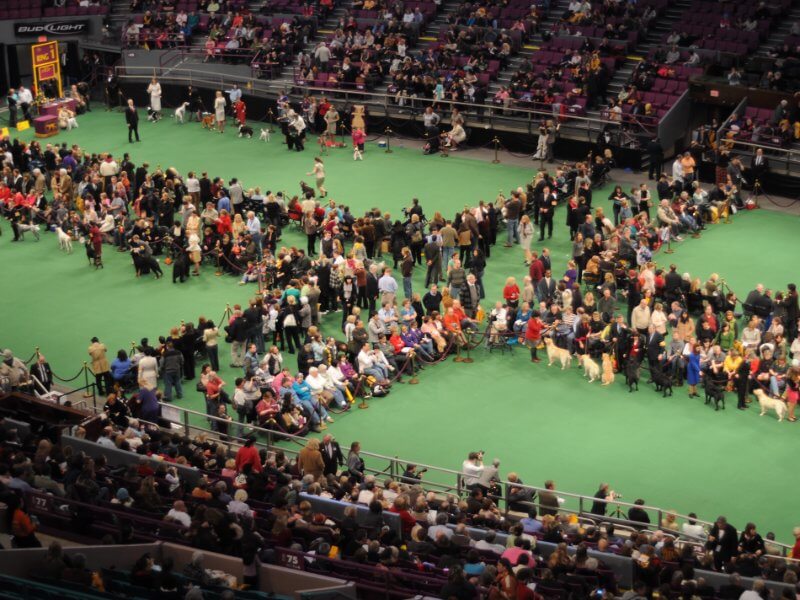A View From the Center of the Ring – Exhibitors Can Learn a Lot From Judging Assignments
In dog shows, as in life, nothing takes the place of doing. If you want to learn how to show dogs, reading a book or visiting a website can get you only so far. Eventually, there comes a time when books need to be put down and sleeves need to be rolled up. If you want to breed a Best in Show winner, you need to study pedigrees and get yourself a whelping box. If you want to show a dog to a Best in Show win, you need to become flawless in your presentation. And if you want to award a Best in Show someday, you need to understand the judging process from the center of the ring—which is far more challenging than it appears as an exhibitor, and not at all what it’s like sitting ringside.
The anecdotes which follow have been gleaned from a recent sweepstakes assignment that provided me with an opportunity to better understand the important role that the exhibitor plays in the judging process.
…if you want to award a Best in Show someday, you need to understand the judging process from the center of the ring—which is far more challenging than it appears as an exhibitor, and not at all what it’s like sitting ringside.
GOING SOLO
Unlike exhibiting dogs with friends (and frenemies) by your side, judging is a solo affair. The honor can even make a guy feel like a pariah. This became clear to me when, before my assignment had begun, I bumped into an acquaintance who recoiled at the encounter as though I were an apparition. Initially I felt as though I’d been given the cold shoulder, but I quickly realized that this individual was likely going to be exhibiting a dog to me and didn’t want to appear to be “fraternizing” with the judge. Similarly, as a judge for the day, I needed to appear beyond reproach by interacting exclusively with the show chair, the superintendent, and my ring steward. This, I learned, proved rather difficult when surrounded by so many familiar faces. Nevertheless, I had a job to do and retreated to my car to (re)read the Breed Standard.
RING STEWARDS RULE!
Throughout my recent assignment, I was reminded that an experienced ring steward is invaluable. Not only do these hard-working men and women keep exhibitors organized and classes moving along, they can also keep a judge on schedule, allowing the focus to be directed where it should be—on the dogs. My steward on the day made sure that I understood how to “check-in” exhibitors and record my placements in the judge’s book. Whenever I set my pen down on the judge’s table, the steward had the next class already in position for my initial impression. (I can’t emphasize enough the importance of this “first look!”) And when I’d made my placements, my steward had the trophies and ribbons neatly arranged on the table for distribution—and the next class already stacked in catalog order for my attention. It is ring stewards like mine who keep our shows running like clockwork.
TICK TOCK, TICK TOCK…
Speaking of clockwork, that “two minutes per dog” thing is real! From the center of the ring, time seemed to accelerate, This reminded me why it’s essential for exhibitors to have their dogs prepared for the ring. Every misstep (mine as well as those of the exhibitors and their dogs) cost precious seconds intended for the evaluation process. Anything that “slowed down” the judging process, from handling errors to a dog pacing or sitting during the exam, prevented good dogs from being assessed as such. Likewise, following the judge’s instructions allowed each dog to be evaluated in the best possible light. By doing so, every dog’s strengths were enhanced and their shortcomings minimized. I learned, by providing a bit of guidance, that judges really do want to help exhibitors present their dogs to best advantage.
WHAT TO WEAR?
Although I’d wanted to look “officious” for my judging assignment and dressed accordingly, one somewhat surprising takeaway after the fact was that I hadn’t taken notice of the exhibitors’ attire. I don’t know if the ladies wore skirts or the gentlemen wore neckties, and I took no notice of the exhibitors’ footwear. The only exception to this lack of awareness on my part were the hats worn by a few of the ladies, and I only realized they were wearing hats because I had to peer under a brim to provide them with instruction.
I also hadn’t taken note of the show leads on the dogs, except when their positioning prevented both the dog and handler from moving at their best. I was, however, keenly aware of loose leads on dogs that moved freely and without restriction. Perhaps more than anything else, this made my time in the center of the ring an invaluable learning experience as an exhibitor.
STANDARDS MATTER
As a student of the Breed Standards, I found myself mentally revisiting the Standard throughout my assignment. As I viewed each class together in the ring, the words of the General Appearance section came to the fore. During each exam, the breed hallmarks took on greater significance. As each dog moved down and back, strengths (or weaknesses) of construction became apparent, and on the go-around, balance and efficiency came to light. And I was reminded throughout that breed character is always on display. The words of the Breed Standard (both implied and literal) are the only guide by which decisions in the ring should be made. As a judge for a day, those words allowed me to use my eyes without prejudice and my hands without hesitation.
As exhibitors, we sometimes view the judging process as an adversarial one: judge vs. exhibitor; owner handler vs. professional handler; us vs. them. In truth, we are all competing against the Breed Standards—and the last time we were in the ring. Our job as exhibitors is to present dogs that are undeniable representatives of their breed. The role of the judge, by comparison, is to reward those dogs which cannot be denied for their breed type. The two serve each other in our shared desire to preserve type while improving quality. And, as I’m beginning to better understand, the decisions made in the ring can honestly be influenced by exhibitors who show up with dogs that are prepared to win.
As exhibitors, we sometimes view the judging process as an adversarial one: judge vs. exhibitor; owner handler vs. professional handler; us vs. them. In truth, we are all competing against the Breed Standards—and the last time we were in the ring.









